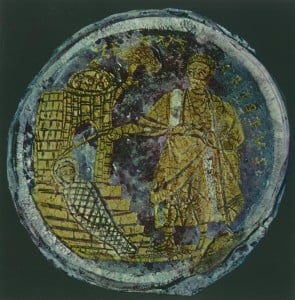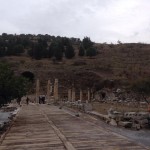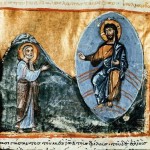
What It’s About: Gentiles! This is about how Peter’s accumulated experiences have led to this point, where he now understands God’s mission as extending to all people.
What It’s Really About: It’s hard to understand this passage without reading it in the context of the first part of chapter 10, which is Peter’s vision of the sheet coming down from heaven. There is an elaborate and involved back-story here, involving Peter and Paul (and who knows who else) and the question of the scope of God’s work, but this passage is very much about Peter articulating a kind of universality to God’s grace–the kind that is most associated with Paul, in the New Testament.
What It’s Not About: In Acts more than any other book of the New Testament, the speeches are not about the historical record. Luke (whoever wrote Luke also wrote Acts, and since both are anonymous we usually call the author “Luke”) is fond of big speeches, and Acts is full of them. These shouldn’t be understood as transcripts of any historical event; rather, these speeches are probably Luke’s take on what someone like Peter would have said in that kind of a situation. To our modern, post-Enlightenment ears, this sounds sneaky or dishonest, but it was absolutely normal in the ancient world, and anyway, Luke never claims to be giving the kind of historical account that we would prefer. This is pre-modern history, and the speeches, including this one, are more about theological posturing than they are about recording the actual words of any particular character.
Maybe You Should Think About: Maybe you should think about why this is in the lectionary for Easter Sunday. My money is on verses 39 and 40, which contain a short little synopsis of what the death of Jesus meant to late-first-century Christians. It’s always an interesting question, for my anyway, how the meaning of Jesus’ life and death both changed and stayed the same over time. Here, we see one perspective on it from the first century. Look at verse 40: who is the agent here? Who has the control and who does the acting?
What It’s About: Life and death.
What It’s Really About: As with many of the psalms and readings from the prophets the lectionary has given us throughout Lent, this one is a text about being beset by enemies. It’s about the psalmist’s cry to God from the midst of suffering and persecution. These kinds of texts were seized upon by early Christians to explain the death of Jesus, which they viewed as a parallel example of a righteous person being unjustly persecuted by enemies.
What It’s Not About: It’s not about verse 12, and that’s too bad. “They surrounded me like bees.” What a powerful image!
Maybe You Should Think About: What about beginning the service with this reading? Verses 1 and 2 (and 3 and 4, for that matter) can serve as a kind of mantra for Easter morning. The remainder of the psalm will be a reminder of the events that took place over holy week, and will only serve to heighten to the Easter proclamation that will follow.
What It’s About: Paul’s kerygmatic message about Christ.
What It’s Really About: This is Paul saying what he thinks is important about Jesus. In the Acts text above, we saw Peter do the same–Peter gave his late-first-century take on the death of Jesus. Here, Paul tells his version, from the middle of the first century. It’s spare and unadorned, but full of the basic tenets of what would in later centuries become the Christian message.
It’s interesting to ask how much Paul really knew about Jesus. Paul either doesn’t know about, doesn’t care about, or doesn’t care to relate very much of Jesus’ life or teaching. Most of what he does relate, he does in 1 Corinthians, here in chapter 15 and also in chapter 11 around the Lord’s Supper. Since Paul was writing letters, and not gospels, he simply might not have had opportunity to tell the stories he knew about Jesus. Or he might have been, as he puts it here, “one untimely born,” and not privy to very much information about Jesus’ life.
In any case, we are left with very little of Jesus’ life and teachings from the pen of Paul. What we do have, though, is a deep theological sense of Jesus meant. That’s what we see here: Paul’s little synopsis of what is important about Jesus. And he frames it in terms of what he has proclaimed, which is in turn what he had received. That is, Paul already stands in a tradition of passing along teachings about Jesus, even in the middle of the first century. This is a remarkable text, in that it points to two things: to Paul’s synopsis of what Jesus meant, but also to the tradition that stood behind that synopsis.
What It’s Not About: It’s not about Paul’s ego. This is somewhat out of character for Paul, who more than any other character of the New Testament is full of confidence and pride about his own gifts and calling. But here, Paul is deferential and humble, perhaps suggesting that he understands his own place in the line from Jesus to Paul’s own present.
Maybe You Should Think About: Maybe you should think about reading this text, alongside Peter’s words from Acts, as a kind of response to the resurrection story that we have from John. In the John text (see below), we have some narration of the events. But in Acts and 1 Corinthians, we have theology to go along with the narration.
What It’s About: Resurrection!
What It’s Really About: You tell me. There seem to be a few subsurface agendas being worked out here. Verses 4 and 8 describe a strange kind of footrace that must have held great significance to the author of the gospel, but the meaning of it is mostly lost to us. And verse 17 also sticks out a bit in the reading. Why did Jesus say this, in the flow of the narrative (did she try to hold on to him?) and in the metaphysical sense (is this a commentary on corporeality)? The great bible scholar and clergyperson Krister Stendahl once recommended that you find where the text defies your expectations, and choose that spot to begin your exegesis. This passage is rich in strangeness and defied expectations, even as it triumphantly conveys the story of the resurrection.
What It’s Not About: It’s not the gospel of Mark. That’s for sure. The gospels differ from one another in many respects (and saying so ought not injure our opinion of them), but nowhere is the difference as stark as it is between these verses and the original ending of Mark, which can be found in 16:1-8. Mark ends in confusion and terror and amazement, and if you hadn’t read the other gospels, you might well be left wondering what had just happened. John’s resurrection story, in contrast, is wrapped up nicely and explained in verse 18, and then another chapter and a half are added to make the landing softer. The intervening generation(s) between Mark and John had allowed Christian theology to make a lot more sense of the resurrection. Whether that is an improvement or not is a matter of taste.
Maybe You Should Think About: Maybe this passage should be read in a woman’s voice. Women (here, Mary) have such a prominent role in the stories of the empty tomb. It was important, to the evangelists, to have women there. We can honor and replicate that presence by having the reader be a woman.












